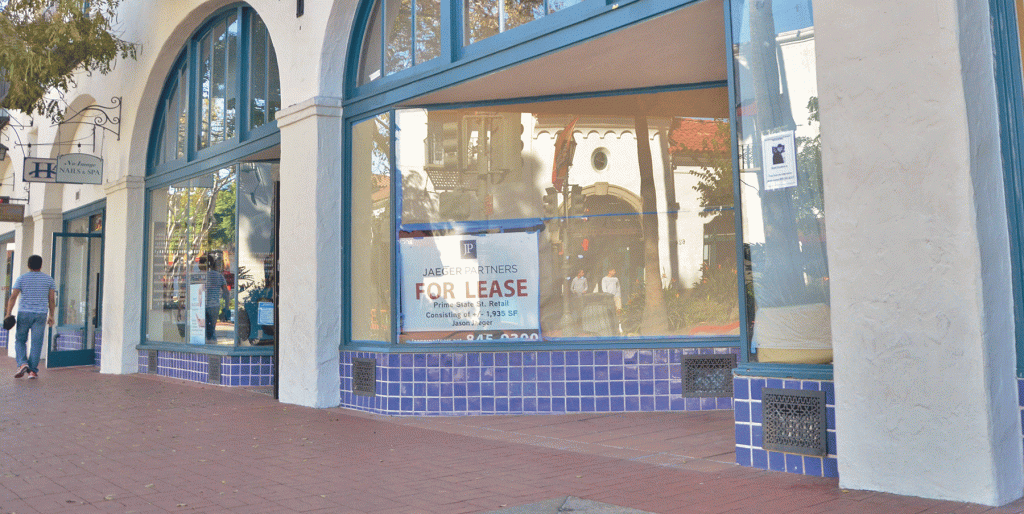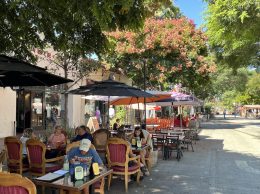State Street woes reflect failed vision by city of Santa Barbara
IN THIS ARTICLE
- Latest news Topic
- pacbiztimes Author
By pacbiztimes Friday, September 14th, 2018

State Street in Santa Barbara has dozens of vacant properties for lease.
Don’t blame the economy for State Street’s continued saga of vacancies, homelessness and ongoing retail slump in downtown Santa Barbara, Peter Rupert, executive director of the UC Santa Barbara Economic Forecast Project, told the audience at a midyear economic update on Sept. 5.
“Can we just blame the economy for this? Well the answer is, actually no. The economy is doing great,” he said.
Rupert presented reports showing the national GDP rising, the stock market going up three-fold since 2008, household net worth at the highest it’s ever been in the U.S. and more vacancies in the U.S. labor market than unemployed people to fill them.
E-commerce sales have gone up since the late 1990s, but still make up less than 10 percent of all sales, which Rupert said rules out the notion that online shopping is mainly responsible for brick and mortar retailers closing up shop in downtown Santa Barbara.
Midge McCauley, founder and principal at Downtown Works and co-author of the 2017 retail assessment of State Street for the Santa Barbara Downtown Organization, said consumers still rely heavily on brick and mortar shopping, including storefront windows and a business’s “edit,” or stylistic selection of products that reflects its brand.
“While things are certainly happening with online sales, many of those online businesses that were initially just going online have gone to brick and mortar,” she said. “And they find that their sales increase significantly because they have both.”
A look at the thriving and growing Funk Zone area near Santa Barbara’s waterfront also points to State Street’s inability to keep up with the growing economy.
Rupert’s data charts showed U.S. retail employment up by about 3 percent, compared to where it was in 2007, the year prior to the Great Recession. While retail employment in Ventura County is up more than 6 percent since 2007, Santa Barbara County is 8 percent below its 2007 numbers.
In an interview with the Business Times, Rupert explained that retail employment data is often used to indicate the health of a local economy. A community with retail jobs means that people are earning enough to go out and eat, shop and purchase goods.
The question remains as to how much weight State Street pulls in Santa Barbara County’s economy, Rupert said, although it constitutes “the bulk” of Santa Barbara city’s retail and service markets.
During the event’s panel discussion, Francois DeJohn, a partner at Hayes Commercial Group, said he was most concerned by the trends Rupert revealed: national retail employment on the rise, with Santa Barbara lagging behind.
“The thing that worries me the most is actually the stuff (data) that you (Rupert) put on the screen,” DeJohn said. “That we are in an incredible expansion economy — the office sector, the industrial sector is doing very well. Here we have 35-40 vacancies on State Street in the middle of a boom. What’s going to happen when the economy pickles?”
DeJohn suggested property “repositioning” along the 400 and 600 blocks, including adding residential development to “bring life back into the downtown area.”
In her presentation, McCauley reiterated the need for an analysis of the downtown area to determine how much demand exists along State Street for retail, suggesting a more concentrated focus on the blocks between Cota and Victoria streets.
She also stressed the need for a comprehensive strategy for the downtown area, as well as a retail advocate to pitch and sell the strategy to businesses and landlords on State Street, using renderings to give them ideas of what a space could look like and how it might benefit the area as a whole.
“Looks matter. How the stores are put together, what their branding is, is extremely important,” she said. “Your (Santa Barbara community’s) reputation and brand are not consistent with what people are coming to the city and buying — or what people who are living and working here are finding in their downtown.”
• Contact Annabelle Blair at [email protected].
Related Articles
 Thursday, October 6th, 2022
Thursday, October 6th, 2022











